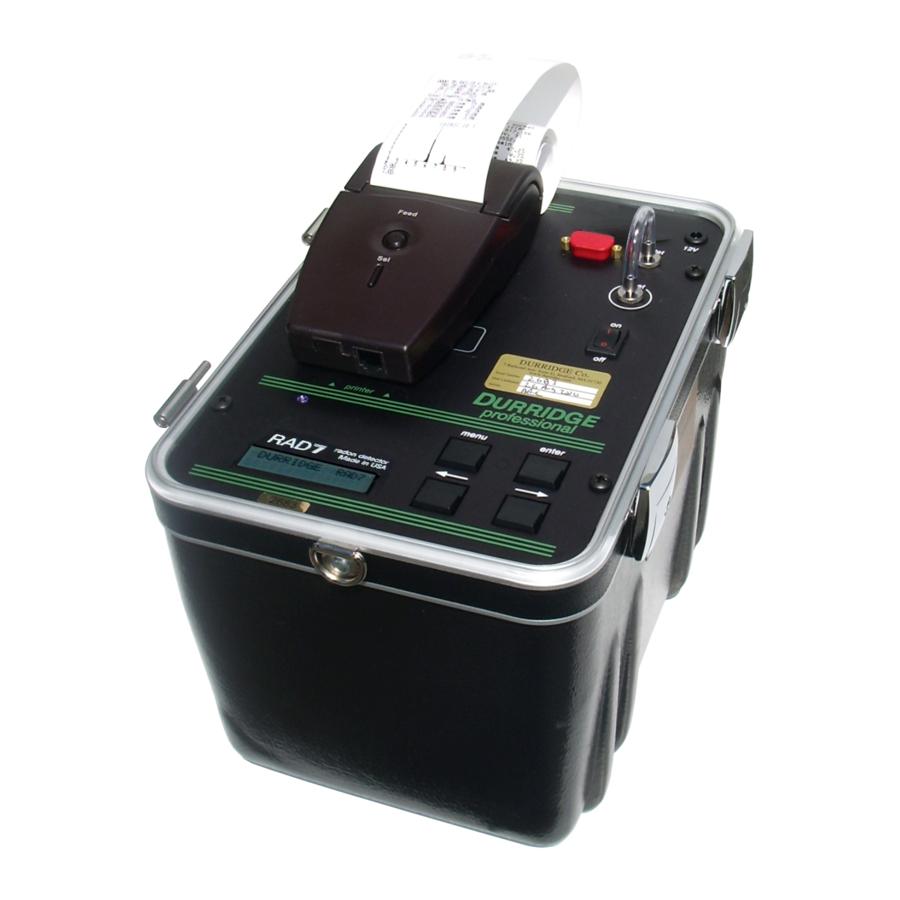
DURRIDGE RAD7 User Manual
Passive, slow response radon in water accessory
Hide thumbs
Also See for RAD7:
- User manual (95 pages) ,
- Bluetooth connection manual (4 pages) ,
- Connectivity manual (4 pages)
Subscribe to Our Youtube Channel
Summary of Contents for DURRIDGE RAD7
- Page 1 WATER PROBE Passive, Slow Response Radon in Water Accessory for the RAD7 User Manual ...
-
Page 2: Table Of Contents
INTRODUCTION Fig. 1 Assembled Water Probe 1 WATER PROBE SETUP 1.1 Connections 1.1.1 Air Loop Fig. 2 RAD7 Water Probe Standard Setup 1.1.2 DRYSTIK 1.1.3 RAD7 and Exchanger Location 1.1.4 Temperature Probe 1.2 Water Flow and Source 1.3 Air Flow and Pump Setting 1.4 Protocol... - Page 3 4.3 Effect on Response Time 4.4 Custom DRYSTIK Settings Fig. 4 Water Probe configuration with Active DRYSTIK 5 CARE, MAINTENANCE, AND TROUBLESHOOTING 5.1 Water Catastrophe 5.2 RAD7 Care 5.3 Exchanger Care 5.4 Desiccant Regeneration 5.5 Water Probe Troubleshooting 5.5.1 Air Path Integrity...
-
Page 4: Introduction
It takes time for the water to deliver radon to the air loop and for the RAD7 to respond to the changed radon concentration. -
Page 5: Water Probe Setup
1.1.3 RAD7 and Exchanger Location Please note that the above instructions are for use of Place the RAD7 on a clean, dry surface. If it has to be the Water Probe without a DRYSTIK humidity located in a harsh environment, then it should be exchanger. -
Page 6: Temperature Probe
: As discussed above, choose 1.3 Air Flow and Pump Setting SETUP TONE : Choose what you like. For proper air flow, the RAD7 pump should be set to SETUP FORMAT LONG : Choose what you like, but Auto. The pump, in Auto operation, pumps for five format uses more paper. -
Page 7: Measurement Procedure
Switch on the RAD7 (have the printer switched on if mode. For this reason, it is almost always sufficient to you are using it. The RAD7 will then print a header set the pump to AUTO mode, in which the air is... -
Page 8: Rad7 Mode
For slow, long-term measurements with long cycle switching from NORMAL to SNIFF mode. times AUTO mode for the RAD7 is appropriate. The RAD7’s response time will be a couple of hours or so. 2.3 Long Term Measurement 2.3.1 Desiccant replaced, and the relative humidity in the instrument rises above about 20%, then the sensitivity drops off... -
Page 9: Data
The RAD7’s infrared printer will print out data in To obtain the water temperature data (optional), short, medium or long format - see the RAD7 manual connect the temperature logger to the computer and for details. In the long format, there will be a run its software to download the data. -
Page 10: Data Conversion Formulas
3.2 Data Conversion Formulas 3.2.1 Fritz Weigel Formula 3.2.2 Schubert Et. Al. Formula The RAD7 gives an accurate reading of the radon If the Water Type is set to Saline Water in concentration in the closed air loop. With the Water CAPTURE’s Run Parameters Window, the radon in... -
Page 11: Drystik
DRYSTIK is typically used because it matches the DURRIDGE’s DRYSTIK ADS-3 and ADS-3R models average flow rate of a RAD7 in AUTO mode, and it include a pump upstream of the inner membrane also matches the performance of the installed pump tube, and a needle valve downstream of the tube. - Page 12 Fig. 4 Water Probe configuration with Active DRYSTIK Section 4 DRYSTIK...
-
Page 13: Care, Maintenance, And Troubleshooting
5.1 Water Catastrophe periodically. This may be obtained by having the If water ever enters the RAD7, or if the RAD7 ever printer on and allowing the RAD7 to complete a run. goes swimming in the water, it will probably cease to The “Recycle”... -
Page 14: References
REFERENCES The following references are in chronological order. Weigel, F, 1978. Chemiker Zeitung, 102 (1978) 287. Schubert, M., Schmidt, A., Paschke, A., Lopez, A., & Balcázar, M. (2008). In situ determination of radon in surface water bodies by means of a hydrophobic membrane tubing. Radiation Measurements, 43(1), 111–120. De Weys, J., Santos, I. - Page 15 Telephone: (978)-667-9556 Fax: (978)-667-9557 Web: www.durridge.com Email: service@durridge.com © Copyright 2021 DURRIDGE Company Inc. All rights reserved. DURRIDGE, the DURRIDGE logo, and the Works with the DURRIDGE logo are trademarks of DURRIDGE Company Inc., registered in the U.S. Revision 2021-08-31...





Need help?
Do you have a question about the RAD7 and is the answer not in the manual?
Questions and answers